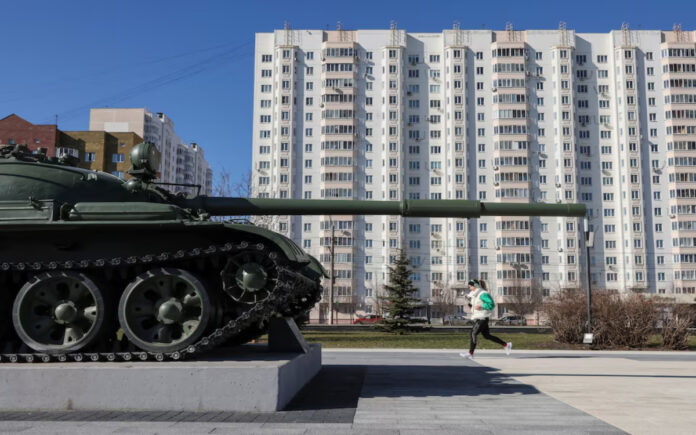Rylsk, Kurk Oblast: Residents of Russia’s Kursk region, which has endured more than seven months of conflict, express a deep longing for peace but remain fearful of further escalation. Ukraine’s unexpected incursion into Russian territory in August—over two years after Moscow launched its full-scale invasion—shocked a region that had not experienced war since World War Two.
Now, as Russian forces near the expulsion of the last Ukrainian troops, Kursk’s residents are left grappling with the human and structural toll of the conflict.
For Leonid Boyarintsev, a veteran of the 1969 Sino-Soviet border conflict, Ukraine’s offensive served as a stark reminder of the need for Russia to intensify its military operations.
“When we are victorious there will be peace because no one will dare to come crawling in again,” the 83-year-old told Reuters in the town of Rylsk, attributing the prolonged conflict to Western interference. “They will be too afraid to.”
A Region Scarred by War
The war has left a visible mark on Kursk, with once-thriving towns now bearing the scars of destruction. In Rylsk, located just 26 km (16 miles) from the border, evidence of the devastation is everywhere—from crumbling Tsarist-era merchant buildings to families torn apart by evacuations.
“We want peace, but it is very important that the peace is long-term and durable,” town Mayor Sergei Kurnosov told Reuters, standing amid the ruins of a cultural center destroyed in a December 20 Ukrainian attack.
Russia reported that six people were killed and 12 injured in the attack, attributing the destruction to U.S.-supplied HIMARS missiles. Inside the wreckage, abandoned music books lay scattered beside silent pianos, while a shattered theater stage stood as a stark symbol of the ongoing war.
Reuters was among the first international news outlets to access the Kursk region since Russia launched its counteroffensive. While Russian officials did not interfere with reporting, journalists were informed in advance that they could not document Russian military positions or operations.
After Moscow launched a lightning offensive to retake Kursk this month, Russia is close to expelling the last Ukrainian troops. However, the damage unleashed on towns has brought home the horrors of war long suffered by Ukrainians https://t.co/yxcQoUXW8U pic.twitter.com/8ZCC2He1Bb
— Reuters (@Reuters) March 27, 2025
Living Under Constant Threat
Much like Ukrainians, Kursk residents yearn for a return to normalcy. Air-raid sirens have become an inescapable part of daily life. Though Russia has nearly expelled Ukrainian forces from the region, vast areas remain heavily mined, and drone attacks continue. Civilian vehicles near the Kurchatov nuclear power plant now routinely carry drone-jamming devices for protection.
“It’s all very scary indeed,” said Rimma Erofeyeva, a music teacher in Rylsk. “The really scary thing is that people have got so used to this that they don’t even react to the sirens anymore.”
The Ukrainian Offensive and Its Fallout
On August 6, Ukrainian forces launched an incursion into Kursk, backed by drone swarms and Western-supplied heavy weaponry. Within days, they had seized nearly 1,400 square kilometers of territory, according to Russian military officials. However, the Ukrainian foothold quickly diminished as Russia reinforced its positions.
The latest battlefield map from Deep State, a respected Ukrainian open-source intelligence platform, indicated that as of March 23, Ukraine controlled less than 81 square kilometers. In contrast, Russia holds approximately 113,000 square kilometers of Ukrainian territory, roughly 20% of the country.
The strategic impact of Ukraine’s incursion remains contested. Ukrainian officials claim the operation successfully diverted Russian troops from eastern Ukraine, embarrassed President Vladimir Putin, and created leverage for potential negotiations.
“The operation achieved most of its goals,” the Ukrainian armed forces’ General Staff told Reuters.
However, Russia’s top military official, General Valery Gerasimov, presented a different assessment during a televised meeting with Putin on March 12. He asserted that Ukraine suffered heavy casualties in a failed attempt to distract Russian forces from their advances in the Donbas.
Also Read | Bolsonaro Faces Trial for Alleged Coup Attempt After 2022 Election Loss
“The Kyiv regime aimed to create a so-called strategic foothold in the Kursk region for later use as a bargaining chip in possible negotiations with Russia,” Gerasimov said. “These plans of the enemy have completely failed.”
According to Russia’s defense ministry, Ukraine has lost 69,700 troops in Kursk, along with 5,700 tanks, armored vehicles, and other Western-supplied equipment. Ukraine has not provided its own casualty figures but dismisses Russia’s claims as propaganda.
Uncertain Future Amid Geopolitical Tensions
Despite growing international calls for a ceasefire, Kursk residents remain skeptical about lasting peace. New U.S. President Donald Trump has vowed to end the war, but deep-seated geopolitical tensions and mutual distrust between Russia and the West continue to fuel anxieties.
Also Read | Jaishankar: India-China Tensions Expected but Conflict Not the Solution
“I don’t think that there will be peace in our region in the near future,” said Yekaterina, a Kursk resident. “There will be some hostility towards our people, towards our land for a very long time.”



